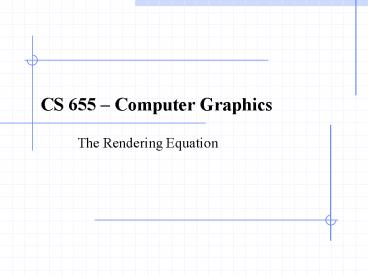CS 655 Computer Graphics - PowerPoint PPT Presentation
1 / 26
Title:
CS 655 Computer Graphics
Description:
Glossy BRDF. Light is reflected unequally in many directions. Several models exist that attempt to represent glossy BRDFs. Phong Model. Blinn - Phong Model ... – PowerPoint PPT presentation
Number of Views:41
Avg rating:3.0/5.0
Title: CS 655 Computer Graphics
1
CS 655 Computer Graphics
- The Rendering Equation
2
The Rendering Equation
- Developed by Kajiya in 1986
- An attempt to unify rendering so that all
rendering has a basic model as a basis - Accounts for all light interactions in an
environment
3
Energy Balance
- Outgoing Incoming Emitted Absorbed
- The total light energy put into the system must
equal theenergy leaving the system (usually, via
heat). - Outgoing Emitted Reflected Transmitted
4
Outgoing Energy
wo
H wi n(x) lt 0
N
wir
N surface normal
wo outgoing energy
wir incoming reflected energy
wit incoming transmitted energy
H- wi n(x) gt 0
H half space above object
wit
H- half space below object
5
BRDF
- Bidirectional Reflectance Distribution Function
- A measurement of the amount of energy being
distributed about all directions from a point.
6
Diffuse BRDF
- Light is reflected equally in all directions
7
Specular BRDF
- Light is reflected only in one direction
8
Glossy BRDF
- Light is reflected unequally in many directions
- Several models exist that attempt to represent
glossy BRDFs.
9
Phong Model
10
Blinn - Phong Model
11
Modified Blinn - Phong Model
12
Outgoing Energy
wo
H wi n(x) lt 0
N
wir
- Outgoing Emitted Reflected Transmitted
H- wi n(x) gt 0
wit
13
Outgoing Energy
wo
H
N
wir
H-
wit
14
The Rendering Equation
Unoccluded two point transfer No participating
media
If occluded, this is 0 If not occluded, this is
the inverse square of the distance between x
and x
Energy emitted from point x that reaches point x
15
The Rendering Equation
The intensity of energy originating from
x, coming through point x, and terminating at
point x The BRDF
16
The Rendering Equation
- In other words, the transport intensity from x
to x is the sum of the emitted light from x that
reaches x, plus all of the light from x that
eventually gets to x through x - We can rewrite the equation as
- Where M is the linear integral operator
17
Breaking Down the Rendering Equation
- Rearranging terms gives
18
Breaking Down the Rendering Equation
Light to x directly from x
Light from light source to x, then to x
Light to x via x scattered twice
Light to x via x scattered three times
etc.
19
Applying the Rendering Equation
- Local reflection models
- only the first two terms are used
- the ge term is non-zero only for light sources
- M operates on e rather than g, so shadows are not
computed
20
Applying the Rendering Equation
- Basic ray tracing
- Mo is the sum of the reflection and refraction
terms - the geo gives shadows, but only for point light
sources - Ambient lighting is accounted for in e
- M is generally approximated by a small sum
21
Distributed Ray Tracing
- An extension of the three component Whitted (ray
tracing) approximation - M is approximated by a distribution around the
reflection and transmission delta functions
22
Radiosity
- by performing the transformations outlined in the
paper, we get - dB(x) is the radiosity of surface element dx
- ro is r(x, x, x) and is constant
- H(x) is the energy incident on the surface
element dx
23
Applying the Rendering Equation
- Extended two pass algorithm by Sillion (1989)
- with
- In the first pass, extended form factors are used
to compute diffuse to diffuse interaction with
any number of specular transfers inbetween - The second pass uses standard ray tracing to
compute specular transfers
diffuse
specular
24
Sampling
- Goal to reduce the variance in the final image
- Sampling uniformly will introduce significant
variance (noise) - Five sampling techniques are introduced
- Sequential uniform sampling
- Multidimensional sequential uniform sampling
- Hierarchical integration
- Adaptive sampling hierarchical integration
- Importance sampling
25
Importance Sampling the Integral Equation
- Path Tracing
- A ray is sent out, then
- either a reflection or transmission ray is sent
- a shadow ray is sent
- The path tracers time is concentrated in the
more important samples
26
Images from the Original Paper
Left ray tracing, 401 minutes Right using the
integral equation, 533 minutes 40 paths per
pixel
Using the integral equation 1221 minutes































